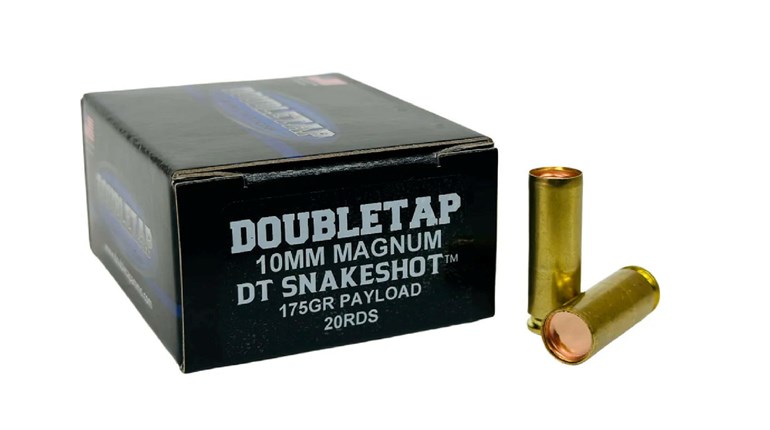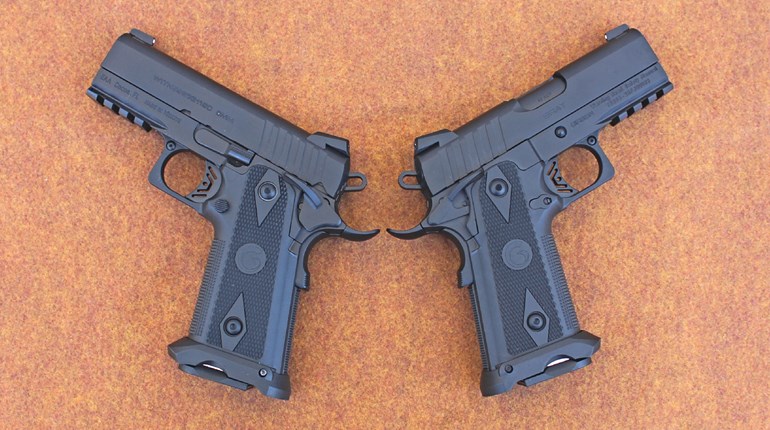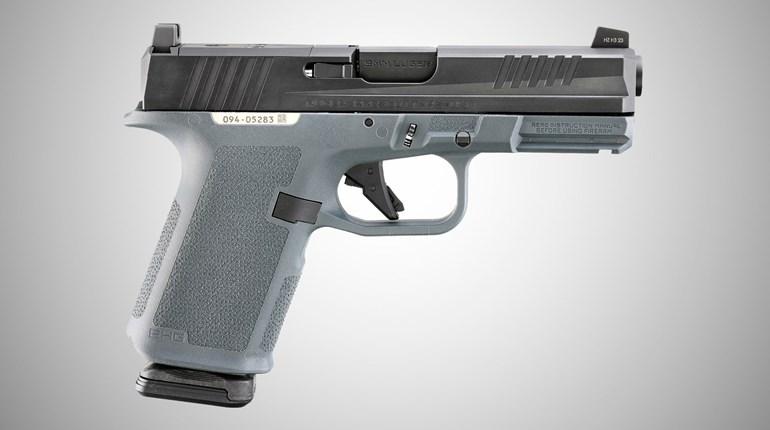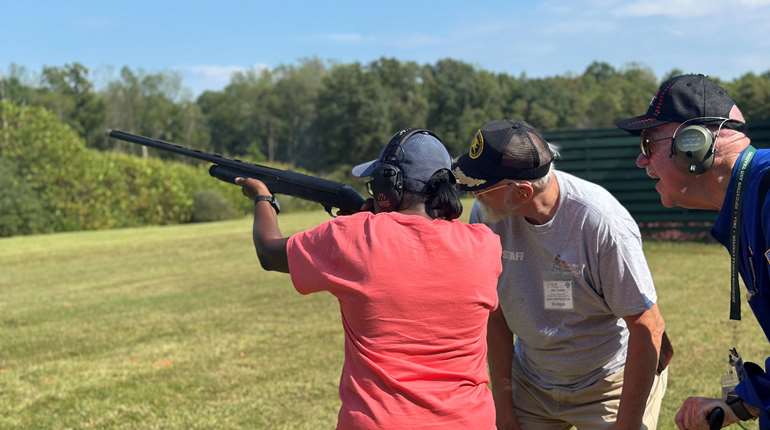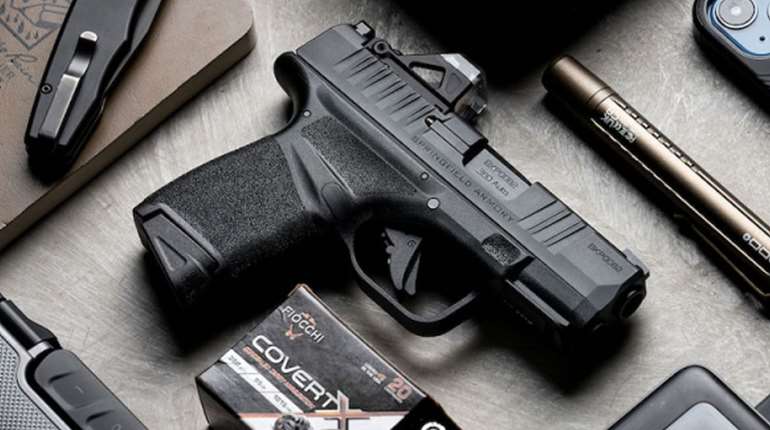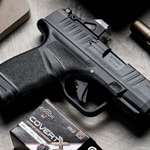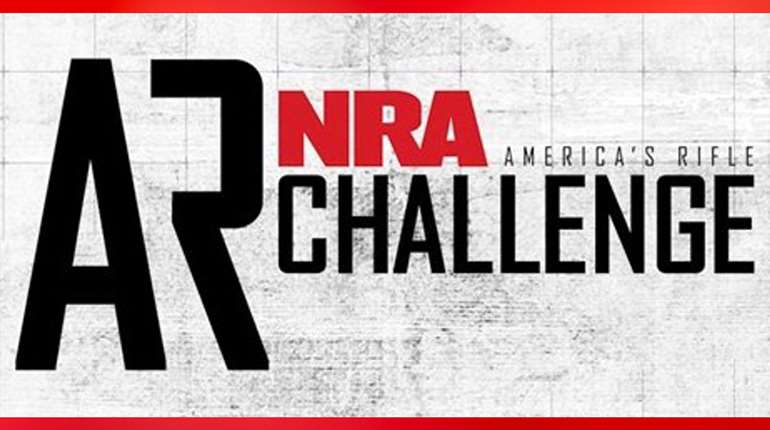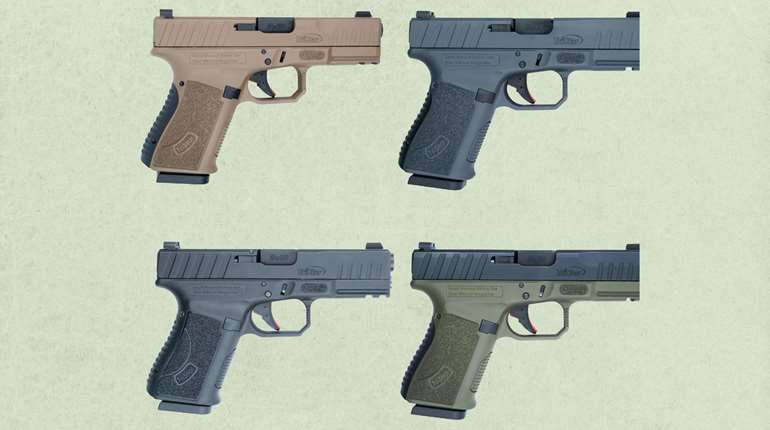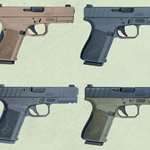
Discussing the use of .410-bore shotguns for home defense often ruffles some feathers. “You should get a 12-gauge shotgun,” they say. “That's the best shotgun for the job!” This sentiment is not untrue, but it's also not complete.
Let me be clear, combat shotguns chambered for 12-gauge shells are, shot-for-shot, among the best close-range fight stoppers yet devised. They throw an impressive amount of lead with nearly irresistible levels of force at across-the-room (3 to 7 yards) and across the house (7 to 15 yard) distances. Lew Gosnell, training director of Gunsite Academy, summed it up quite succinctly during a 12-gauge shotgun demonstration when he said, "Shotgun fights don't last for very long."

Combat shotguns chambered in 12-ga., like this Mossberg 590A1, have long been favored for military, law enforcement and home-defense applications.
But due to Newtonian physics, 12-gauge levels of stopping power come at a price. Full-power shells filled with hard-hitting defensive payloads can generate intense levels of felt recoil. The shotguns themselves can be relatively large, heavy and too long in the stock, making them unwieldy for some folks. For this reason, a more complete statement regarding the defensive 12-gauge would be that it's best option if the home defender can manage it.
For this conversation, let's take a look at the reasons why one might choose to stage a .410-bore shotgun for home defense, some of the suitable .410 shotguns currently available and which types of .410 shells are a good fit for personal protection. Some of the guns and ammunition mentioned here fall under the “whatchagot”category of defensive options.
Why Choose a .410 Bore for Home Defense?
The top reasons for picking a .410 bore for home defense were touched on above, namely, gun size and felt recoil. The shotguns are slim, lightweight and often available in compact configurations with the same shorter 18.5" to 20" barrel lengths commonly used with 12-gauge security shotguns.

Mossberg Security and Shockwave models chambered in .410 are slimmer and lighter than 12-gauge models.
But these aren't the only reasons to consider a .410. A shorter-barrel model can share ammunition with longer hunting .410 shotguns or .45 Colt/.410-bore handguns like the Taurus Judge revolver. This saves money for those who use .410 for sporting purposes and reload the shells themselves. In this same vein, sporting models and defensive models that share the same controls, features and levels of felt recoil make it much easier for the self-defender to transition between them. In fact, some models can comfortably be used for both sporting and defensive purposes.
Finally, a .410 may be either the only gun you currently have access to, or, it may be the gun you have at hand when a self-defense situation arises. This means having at least some defense-grade ammunition on hand, and an understanding of what it can do, is a good idea.
A Quick Note on Ammunition Performance
The scientific field of research known as ballistics is dedicated to understanding how firearms and their projectiles perform. What it boils down to for the home defender is this: Projectiles launched by a defensive handgun, rifle or shotgun must penetrate deeply enough that an attacker loses the ability to continue the assault.

.410-bore shells are available with a variety of projectiles.
But how much penetration is enough? Back in the late 1980s, the FBI’s Firearms Training Unit (FTU) established a series of ammunition performance protocols in which handgun rifle and shotgun rounds are fired into 10% ballistic gelatin. As a rule of thumb, they are looking for projectiles that travel through the gel to an optimum depth of 12” to 18”. Projectiles that penetrate less than 12” are not considered a good fit for home defense. This standard is used for the Clear Ballistics synthetic gel test results included below.

Ballistic gel testing is a good way to evaluate ammunition performance.
It should also be noted that several of the defense-grade .410 shells available these days were developed for the popular Taurus Judge .45 Colt/.410 revolver. The performance of these defensive handgun shells improves when fired from 18.5" to 20" shotgun barrels.
.410 Bore Shells for Home Defense
Originally developed by Eley Brothers of England in 1874, the .410 bore is one of the smallest shotgun shells commonly in use in the United States today. It is currently available with birdshot, buckshot, slugs and mixed payloads. Let’s take a look at each and see how they fit into a self defense plan.
Birdshot
Long guns chambered for this round are eminently suitable for small game hunting, pest control and for more experienced sporting clays enthusiasts when the shells are filled with tiny lead pellets which are commonly referred to as “birdshot.” The vast majority of .410 shells manufactured in the past, and today, are topped off with various sizes of birdshot.
However, the small and relatively light birdshot loads launched by .410 shotguns are poorly suited for self defense applications. When fired from .410 shells, birdshot payloads are quite small when compared to larger shot shells, the pellets tend to spread apart relatively quickly and they do not penetrate deeply enough to reliably stop a threat.

Shown here is a gel block shot with the only “defensive” birdshot load I'm aware of, Federal Premium's 2½” long .410 Handgun load topped off with 7/16 oz., or about 60 pellets, of copper plated #4 birdshot with a listed muzzle velocity of 1200 f.p.s. (a velocity that's similar to larger shot shells).
The pellets stopped at distances between 4" to 8.5" in the gel block with the majority of pellets stopping somewhere between 4.5" to 6.5". This is well below the FBI’s 12” minimum. Being peppered with this .410 birdshot load would be an excruciatingly painful wake up call, even for an assailant wearing thick clothing. However, due to the pain nullifying effects of drugs and adrenaline, self defenders can't count on pain alone to deter a determined assailant. Due to low levels of penetration, it's best to reserve .410 birdshot loads for pest control, sporting clays and small game hunting. If birdshot is “whatchagot,” then be aware of its limitations and plan accordingly.
Buckshot
Buckshot is comprised of much larger and heavier round lead pellets than those used in birdshot. It's a popular option shell configuration for hunting and home defense because of the advantages it offers at close range. The individual pellets have enough mass and momentum to produce effective levels of penetration and tissue damage. However, several pellets are launched simultaneously. If they strike the target at close range, while still clustered together, they produce a massive impact. If the target is further away, and the pellets spread out to form a pattern, then the pellets form multiple wound tracks. The effect is roughly comparable to being struck with multiple .38-cal. or 9 mm round-nose bullets at the same time.
Reliable .410 buckshot loads are available in 2½” or 3" shell lengths from major American manufacturers including Federal Premium, Remington and Winchester. The most common buckshot pellet size is 000 (triple-aught). These are .36-caliber (.36") balls that weigh about 70-grains. The 2½” shells are loaded with three or four pellets while the 3" shells are usually packed with five pellets. Because they are stacked one on top of the other in a row inside the shell (instead of in a cluster) they tend flatten out, or “pancake” as they travel through the barrel.

Shown here is a before-and-after picture of the four copper plated pellets fired into gel from a Federal Premium .410 Handgun shell with a listed velocity of 1200 f.p.s. for 224 ft-lbs. of muzzle energy for each pellet. The pellets average depth in bare gel was 20.7" with four distinctive .36 to .38-cal. wound tracks behind each pellet.
Essentially, the only real difference in defensive performance for .410 buckshot shells, when compared to that of reduced-recoil 12-gauge buckshot loads containing 8 or 9 pellets, is the number of pellets fired. I've had mixed reliability results with some imported polymer-hull .410 buckshot loads. They tend to run reliably in some guns but not others. The imported shells with all-metal hulls that I've worked with have jammed up every handgun and long gun I've tested them in, badly. I had to drive the spent hulls out of the gun chambers with a hammer and a cleaning rod. My advice is to avoid them completely for self-defense purposes.
Slugs
Slugs are one-piece projectiles used to extend the range of shotguns when hunting. They essentially turn a shotgun into a medium-range rifle. The only type of .410 slug I've gel tested so far is the Remington Express .40-cal. 1/5 oz. (87.5-gr.) rifled lead slug. It's a nearly hollow round-nose configuration which launched at 1752 f.p.s. and hits into the gel with 596 ft.-lbs. of energy. However, as you can see from the photo here, the slug shattered on impact. The fragments only traveled between 2.5" to 4" into the gel. Like birdshot, this type of slug should be relegated to sporting purposes or whatchagot status.

Mixed Payload Shells
The following two 2½” shells were developed specifically for the Taurus Judge revolver. But both produced impressive gel test results when fired from an 18.5" defensive shotgun.
Winchester's mixed-payload PDX1 Defender fires three, pre-flattened .40-cal. copper-plated lead discs, followed by 12 pieces of BB size copper-plated lead shot, at an average muzzle velocity of 1073 f.p.s .from an 18.5" barrel. The three disks penetrated an average depth of 27.25” with the 12 pieces of BB shot pellets penetrating between 5" to 26.5".

The Hornady Critical Defense Triple Threat load fires a .41-cal. 115-gr. FTX hollow-point lead slug followed by two .35-cal., .65-gr. round lead pellets with a muzzle velocity of 1116-f.p.s. When fired into the gel bock the .41-caliber FTX slug successfully expanded to .64-cal. and traveled 14.50". But as you can see here, the slug took some damage as the two .35-cal. pellets went past it to stop at 23.5" and 26". The slug's polymer wad traveled 13.25" into the block, effectively making it a fourth projectile.

Which Shells for Home Defense?
Here's what all of this ammunition testing information boils down to: Loading shorter-barrel .410-bore shotguns with buckshot loads, or defense-grade mixed payload shells, turns the gun into a viable low-recoil home defense option. This gun and ammunition combination launches more projectiles per trigger pull than a handgun but does so without the punishing recoil of a 12-gauge shotgun. But remember, birdshot and slugs should be reserved for sporting purposes.
Compact .410 Bore Shotgun Options
In pursuit of an understanding of the defensive capability of .410 shells, I've run them through a variety of long guns. Here are a few of the shorter barrel models found in the market place today.
Single-Shot Break Action Shotguns
The hinged-barrel, single-shot shotgun is one of the most prolific .410-bore action types available. These svelte little guns are lightweight, ruggedly reliable, easy to operate and usually available at most sporting goods stores for low prices. There are several entry level variations available from manufacturers including the Hatfield Gun Company, Iver Johnson, Rossi USA, and Stevens (Savage Arms).

Rossi Tuffy
These shotguns are great for training youthful shooting sports enthusiasts, small game hunting and they are favored for use as emergency survival and “trunk” guns. However, their limited ammunition capacity and slow rate of fire are not a great fit for home defense. This is strictly a whatchagot option. But if you own one, having at least a few defense-grade shells on hand is a good idea.
Stoeger Industries Double-Barrel Coach Gun
There are not too many budget-friendly traditional 2-trigger, double-barrel shotguns to choose from these days. But Stoeger Industries does offer a slim and a handy little 20" barrel coach gun in .410 with suggested retail prices starting at $479.

Stoeger Coach Gun
We have one in the family that's been used for everything from plinking to pheasant hunting. Like single-shots, the double barrels have a lower rate of fire and a slower reload. But double guns are reliable, easy to operate and have served in defensive roles many, many years.
Mossberg Pump-Action Youth & Security Models
Pump-action shotguns with shorter 18" to 20" barrels, also known as “riot guns,” have been a standard for home defense since the early to mid 20th century. They are tough, reliable and offer a quick rate of fire with some practice. Most models can also be loaded on the go because the tubular magazine port is accessible with the action closed.

Mossberg 505 Youth
Over the years Mossberg has offered more home-defense ready .410 pump-actions than any other American manufacturer. The Model 500 is chambered for 2½” and 3" shells with a 5+1 ammunition capacity. Options have included flexible youth models, like the wood stocked 505 Youth (#57120, MSRP: $473) shown here. Youth models have shorter shoulder stocks and pump grips which have been moved closer to the receiver. This makes them a better fit for small frame shooters of all ages.
Model 500 18.5" barrel Security configurations have been available with either synthetic shoulder stocks or pistol grips. They even offer a 590 Shockwave non-NFA firearm with a 14" barrel. I've worked with these guns extensively and found them to be just as reliable and user friendly as the models chambered for larger shotgun shells. Although not all of them are currently in production, due to high demand for 12-ga. shotguns, then can still be found for sale with a bit of internet research.
Henry Lever Action .410 Shotguns
Although various companies have offered .410 lever guns over the years, Henry Repeating Arms' .410s are among the toughest yet built. This is because they are based on the company's all-steel .45-70 Gov't. rifle action. This gives these shotguns an unloaded weight of 7.5 lbs., which soaks up felt recoil like a sponge.

Henry X Model
Chambered for 2½” shells only, these guns have quick, intuitive handling, a 6-round ammunition capacity and removable choke tubes. The side loading gate found on the right side of the receiver allows the magazine tube to be topped off as needed, much like that of a pump action. The company offers two wood-stocked models with either a 24" or 19.75" barrel. The X Model is outfitted with polymer stocks, fiber optic sights and a 19.8" barrel. Suggested retail prices start at $1,017.
Often dismissed as ineffective for personal protection, .410 shotguns can get the job done when loaded properly.












